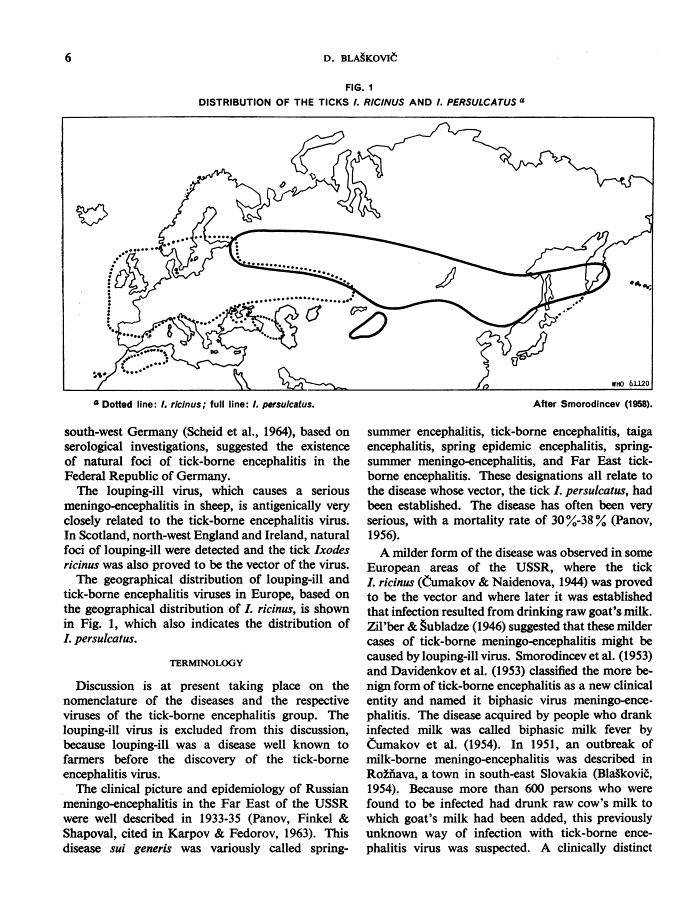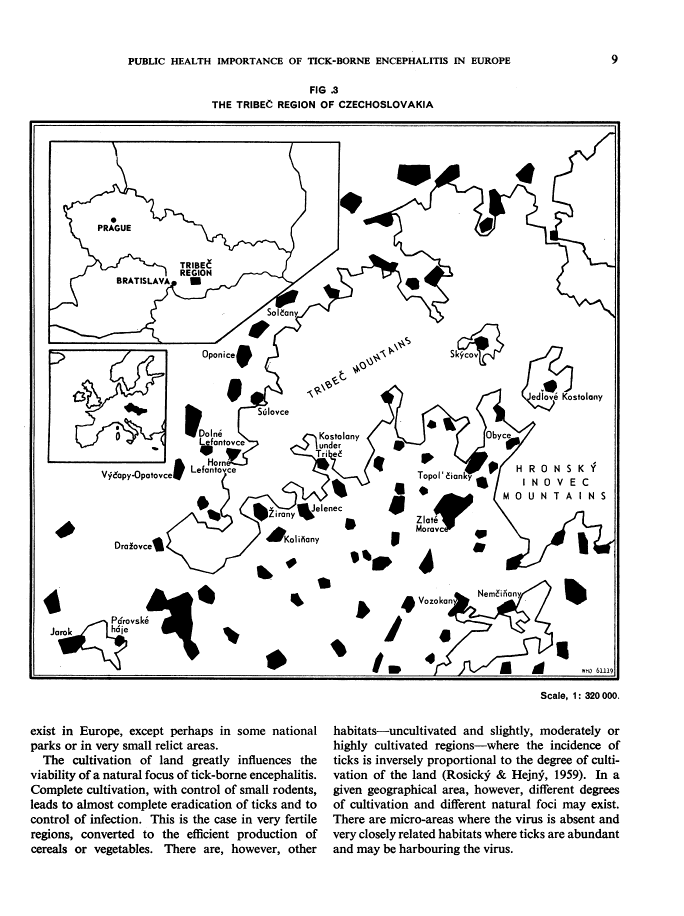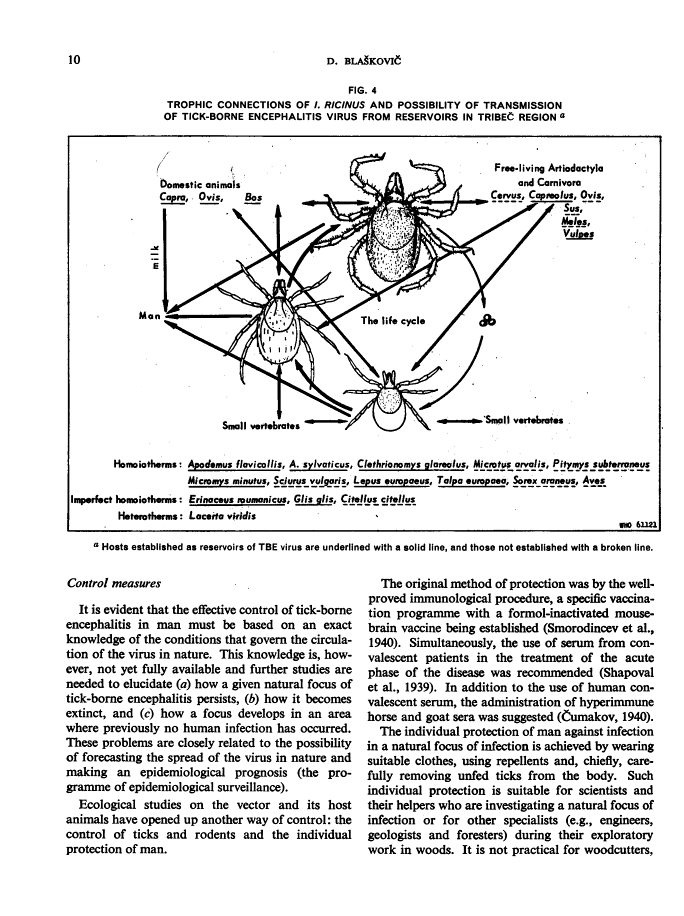Abstract
Free full text

The public health importance of tick-borne encephalitis in Europe
Abstract
After an historical survey establishing the distinction between Russian spring-summer encephalitis, a serious disease with a high mortality rate caused by a virus spread by the tick Ixodes persulcatus, and the milder Central European encephalitis, which is spread by I. ricinus, the public health aspects of the latter disease are discussed. The factors affecting the incidence of the disease—tick population, role of rodents and insectivores, etc.—are considered. Only a small proportion of those infected develop clinical symptoms. Measures for the control of the disease include (a) vaccination of humans, (b) reduction of the tick population by cultivation of the land, by spreading the enemies of ticks and by dusting with insecticides, and (c) reduction of the infectivity of ticks by vaccination of domestic animals. It is concluded that, under the conditions prevailing in Central Europe, mass vaccination is not to be recommended, although those working regularly within a natural focus of infection should be vaccinated.
Full text
Full text is available as a scanned copy of the original print version. Get a printable copy (PDF file) of the complete article (1.4M), or click on a page image below to browse page by page. Links to PubMed are also available for Selected References.
Selected References
These references are in PubMed. This may not be the complete list of references from this article.
- BEDJANIC M, RUS S, KMET J, VESENJAK-ZMIJANAC J. Virus meningo-encephalitis in Slovenia. Bull World Health Organ. 1955;12(4):503–512. [Europe PMC free article] [Abstract] [Google Scholar]
- BENDA R, DANES L. Study of the possibility of preparing a vaccine against tick-borne encephalitis using tissue culture methods. 3. Experimental principles for safety tests of virus inactivation in formolized liquids. Acta Virol. 1960 Sep;4:296–307. [Abstract] [Google Scholar]
- Chumakov MP, L'vov DK, Gagarina AV, Vil'ner LM, Rodin IM, Zaklinskaia VA, Gol'dfarb LG, Khanina MK. Izuchenie uslovii, vliiaiushchikh na éffektivnost' immunizatsii protiv kleshchevogo éntsefalita. I. Vliianie immunogennykh svoistv vaktsiny na éffektivnost' vaktsinatsii i revaktsinatsii. Vopr Virusol. 1965 Mar-Apr;10(2):168–172. [Abstract] [Google Scholar]
- FORNOSI F, MOLNAR E. Adatok a hazai elofordulásu encephalomeningitisek kérdéséhez. Orv Hetil. 1952 Aug 31;93(35):993–996. [Abstract] [Google Scholar]
- GRINSCHGL G. Virus meningo-encephalitis in Austria. II. Clinical features, pathology, and diagnosis. Bull World Health Organ. 1955;12(4):535–564. [Europe PMC free article] [Abstract] [Google Scholar]
- KMET J, VESENJAK-ZMIJANAC J, BEDJANIC M, RUS S. Virus meningo-encephalitis in Slovenia. Bull World Health Organ. 1955;12(4):491–501. [Europe PMC free article] [Abstract] [Google Scholar]
- MORITSCH H, KRAUSLER J. Die endemische Frühsommer-Meningo-Encephalo-Myelitis im Wiener Becken (Schneider'sche Krankheit). Wien Klin Wochenschr. 1957 Dec 6;69(49):921–contd. [Abstract] [Google Scholar]
- OKER-BLOM N. Kumlinge disease; a meningo-encephalitis occurring in the Aaland Islands. Ann Med Exp Biol Fenn. 1956;34(3):309–318. [Abstract] [Google Scholar]
- PATTYN SR, WYLER R. Méningo-encéphalite à virus en Autriche. IV. La virémie dans l'infection expérimentale; essais de transmission par les moustiques. Bull World Health Organ. 1955;12(4):581–589. [Europe PMC free article] [Abstract] [Google Scholar]
- PRZESMYCKI F, TAYTSCH Z, SEMKOW R, WALENTYNOWICZ-STANCZYK R, KAMIENIECKA Z, KIRKOWSKA I. Badania nad zapaleniem mózgu kleszczowym; II. Doświadczalne zaka1zenie małp wirusem kleszczowego zapalenia mózgu. Przegl Epidemiol. 1954;8(3):215–218. [Abstract] [Google Scholar]
- RICHLING E. Virus meningo-encephalitis in Austria. I. Epidemiological features. Bull World Health Organ. 1955;12(4):521–534. [Europe PMC free article] [Abstract] [Google Scholar]
- SCHEID W, ACKERMANN R, BLOEDHORN H, LOESER R, LIEDTKE G, SKRTIC N. UNTERSUCHUNGEN UEBER DAS VORKOMMEN DER ZENTRALEUROPAEISCHEN ENZEPHALITIS IN SUEDDEUTSCHLAND. Dtsch Med Wochenschr. 1964 Dec 4;89:2313–2317. [Abstract] [Google Scholar]
- Smith CE. Factors in the transmission of virus infections from animals to man. Sci Basis Med Annu Rev. 1964:125–150. [Abstract] [Google Scholar]
- SZAJNA M. Badania nad zapaleniem mózgu kleszczowym. III. Obraz kliniczny kleszczowego zapalenia mógzu w N. Przegl Epidemiol. 1954;8(3):219–223. [Abstract] [Google Scholar]
- VESENJAK-ZMIJANAC J, BEDJANIC M, RUS S, KMET J. Virus meningo-encephalitis in Slovenia. Bull World Health Organ. 1955;12(4):513–520. [Europe PMC free article] [Abstract] [Google Scholar]
Associated Data
Articles from Bulletin of the World Health Organization are provided here courtesy of World Health Organization
Citations & impact
Impact metrics
Citations of article over time
Article citations
A One-Health Approach to Investigating an Outbreak of Alimentary Tick-Borne Encephalitis in a Non-endemic Area in France (Ain, Eastern France): A Longitudinal Serological Study in Livestock, Detection in Ticks, and the First Tick-Borne Encephalitis Virus Isolation and Molecular Characterisation.
Front Microbiol, 13:863725, 11 Apr 2022
Cited by: 13 articles | PMID: 35479640 | PMCID: PMC9037541
Ticks and their epidemiological role in Slovakia: from the past till present.
Biologia (Bratisl), 77(6):1575-1610, 17 Sep 2021
Cited by: 13 articles | PMID: 34548672 | PMCID: PMC8446484
Review Free full text in Europe PMC
Rodent Host Abundance and Climate Variability as Predictors of Tickborne Disease Risk 1 Year in Advance.
Emerg Infect Dis, 25(9):1738-1741, 01 Sep 2019
Cited by: 13 articles | PMID: 31441762 | PMCID: PMC6711232
Prevalence of tick-borne encephalitis virus in Ixodes ricinus ticks from three islands in north-western Norway.
APMIS, 123(9):759-764, 01 Jul 2015
Cited by: 13 articles | PMID: 26126504
Multilocus sequence typing using mitochondrial genes (mtMLST) reveals geographic population structure of Ixodes ricinus ticks.
Ticks Tick Borne Dis, 5(2):152-160, 19 Dec 2013
Cited by: 12 articles | PMID: 24361120
Go to all (6) article citations
Similar Articles
To arrive at the top five similar articles we use a word-weighted algorithm to compare words from the Title and Abstract of each citation.
[Tick-borne encephalitis in Europe (author's transl)].
Med Trop (Mars), 40(5):509-519, 01 Sep 1980
Cited by: 3 articles | PMID: 6255281
[Reaction of Ixodes persulcatus and of other ticks to DDT dusting of underbrush in foci of tick-borne encephalitis].
Vopr Virusol, 3(5):265-271, 01 Sep 1958
Cited by: 0 articles | PMID: 13604101
Biology of tick-borne encephalitis virus.
Acta Virol, 41(2):115-124, 01 Apr 1997
Cited by: 13 articles | PMID: 9219644
Review
Tick-borne encephalitis.
Clin Infect Dis, 28(4):882-890, 01 Apr 1999
Cited by: 170 articles | PMID: 10825054
Review












